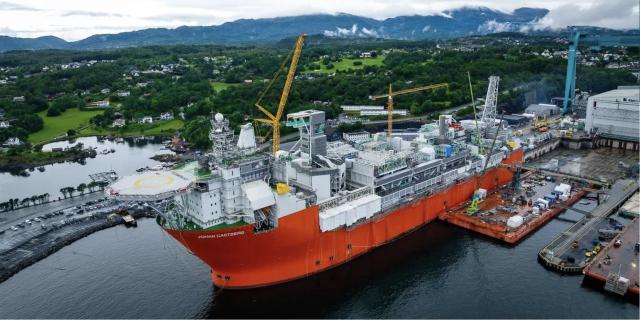
Johan Castberg quayside at Aker Solutions, Stord. (Source: Øyvind Gravås/Equinor)
Norwegian operators Equinor and Vår Energi reported on Sept. 19 that costs for their offshore projects had increased significantly.
Costs for the Equinor-operated Johan Castberg have risen $1.2 billion (NOK 13 billion) in the last year, although it is still on track to begin production in the fourth quarter of 2024, while Vår Energi advised that capex for its operated Balder X project on the Norwegian Continental Shelf has risen by a further $340 million (NOK 3.6 billion) since the operator sounded the price increase alarm in September 2022.
A year ago, Vår cited increased scope of work, the continued impact from global supply chain challenges, COVID-19 and schedule change. Vår said the project required an additional gross investment of $1.2 billion (NOK 11.5 billion),bringing the total estimated gross project cost to $4.3 billion (NOK 40.7 billion). First oil from Balder X was delayed to third-quarter 2024, instead of late 2023.
Vår operates the Balder Field in PL001 with 90% interest on behalf of partner Mime Petroleum with 10% interest.
Vår is also a partner in the Johan Castberg project in 360 m to 390 m water depth in the Barents Sea.
That project has already faced problems, including a June 2021 citation by the Norwegian Petroleum Safety Authority of technical issues with the FPSO’s hull construction and an August 2022 fire on the FPSO.
When Equinor submitted the plan for development and operation (PDO) for Johan Castberg in 2017, the cost estimate was $5.3 billion (NOK 57 billion), but the updated project cost estimate increased to $7.4 billion (NOK 80 billion). Equinor said project costs jumped by $1.4 billion (NOK 15.5 billion) and that a currency effect of $651 million (NOK 7 billion) contributed to the price increase.
Infection control measures and reduced access to labor in connection with the COVID-19 pandemic affected the project, both in Singapore, where the hull and living quarters for the production vessel were constructed, and at Norwegian yards constructing modules for the production facility.
Geir Tungesvik, executive vice president for projects, drilling and procurement for Equinor, said project costs were “increasing due to a larger than expected scope of work and cost increases in the industry.”
In 2022, the Johan Castberg hull, including living quarters, was transported from Singapore to Stord for installation and commissioning. The main reason for the rise in the investment estimate from last year is that the workload transferred to Stord has been more comprehensive and complex than estimated, Equinor said. In addition, the project has not progressed as planned. Marine operations, drilling and completion costs have also increased.
Johan Castberg is a subsea project with 30 wells distributed on 10 templates and two satellites tied back to the Johan Castberg FPSO.
Proven volumes in Johan Castberg are estimated at between 450 MMbbl and 650 MMbbl of oil. The vessel is designed for production of close to 190,000 bbl/d.
Tungesvik said Johan Castberg is “still a good project with a solid economy” and a breakeven of about $35/bbl.
In 2022, two more discoveries were made that are considered for tie-back to Johan Castberg, and further exploration in the area is planned in the years ahead.
Equinor operates the project with 50% interest on behalf of partners Vår with 30% and Petoro AS with 20%.
Recommended Reading
Kimmeridge Fast Forwards on SilverBow with Takeover Bid
2024-03-13 - Investment firm Kimmeridge Energy Management, which first asked for additional SilverBow Resources board seats, has followed up with a buyout offer. A deal would make a nearly 1 Bcfe/d Eagle Ford pureplay.
Laredo Oil Subsidiary, Erehwon Enter Into Drilling Agreement with Texakoma
2024-03-14 - The agreement with Lustre Oil and Erehwon Oil & Gas would allow Texakoma to participate in the development of 7,375 net acres of mineral rights in Valley County, Montana.
SLB’s ChampionX Acquisition Key to Production Recovery Market
2024-04-21 - During a quarterly earnings call, SLB CEO Olivier Le Peuch highlighted the production recovery market as a key part of the company’s growth strategy.
Oil and Gas Chain Reaction: E&P M&A Begets OFS Consolidation
2024-04-26 - Record-breaking E&P consolidation is rippling into oilfield services, with much more M&A on the way.
JMR Services, A-Plus P&A to Merge Companies
2024-03-05 - The combined organization will operate under JMR Services and aims to become the largest pure-play plug and abandonment company in the nation.





